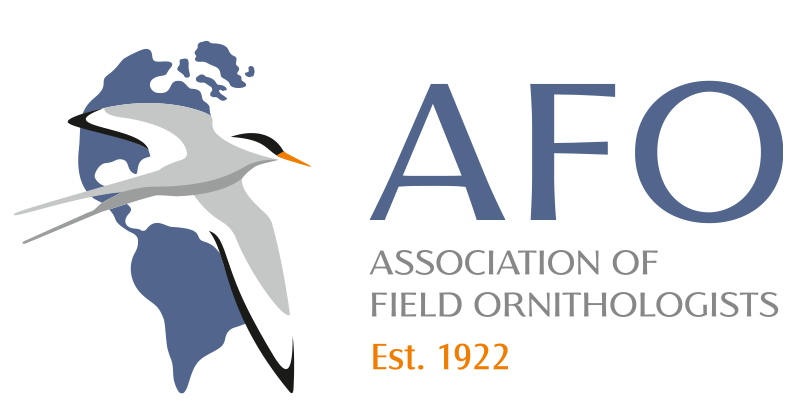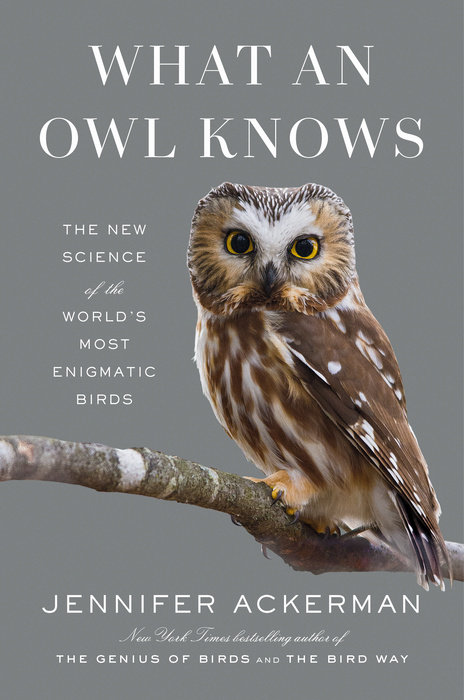https://www.penguinrandomhouse.com/books/673192/what-an-owl-knows-by-jennifer-ackerman/ Jennifer Ackerman. 2023. Penguin Press, New York, New York, USA. ISBN 9780593298886. Hardcover ($30.00 USD).
Jennifer Ackerman is well known for her previous books such as The Bird Way and The Genius of Birds, where she dives into the avian brain and explores the so different but brilliant mind of birds. In this book, she takes her passion for birds and science and explores the world of owls. Humans have a very special bond with owls, and they seem to be the most revered, beloved, but also feared birds in the world and our fascination with them goes back thousands of years. Over the millennia, owls are consistently depicted in art and present in our mythology, often seen as signs and messengers. Indeed, our first known human representation of a bird is a cave painting of either a long-eared or eagle owl from a cave in southern France estimated to be 36,000 years old.
What becomes apparent early in the book, is that Jennifer is just as interested in communicating to us the latest scientific, often fascinating, findings about owls as she trying to tap into why humans and owls have this connection. Indeed, Jennifer does an excellent job interweaving the most recent science about owls, ranging from highly specialized flight adaptations to how their brain is wired to memorize landscapes, to our complex, rich and sometimes tumultuous relationship with them. As in her previous books, Jennifer does not shy away from joining researchers in the field, and experiencing firsthand what it means to go owling. Owl researchers do not shy away from challenges; owls are often elusive, shy, mostly nocturnal, and have excellent camouflage which means you must be innovative and persistent but also curious about owls and how they communicate and perceive the world around them.
There are five researchers whose opinions and experiences Jennifer weaves throughout the book, and perhaps most importantly too, their personal experiences monitoring owls for decades. My only comment here is that these five key researchers which are truly experts in their field are situated in North America. I think haven closely following a researcher outside North America would have enriched this book even more. However, Jennifer does incorporate owl research done on all continents throughout the book.
Owls do not only stir curiosity in ornithologists, but also amateurs that volunteer countless of hours in the field, to further our understanding of owls. These are perhaps the most inspiring stories that Jennifer bring us, and passion is a common denominator for all of them. Such is the case for Marjon Savelsberg, a classical musician by training that had to give up her musical career due to a deteriorating heart condition but found a new way to use her talents for music and sounds in the owl world. She started listening to owls live streamed on webcams and this morphed into venturing out at night on her mobility scooter listening and recording the sounds of Eurasian eagle owls in the Maastricht quarry in the Netherlands. She is considered an expert on the vocalizations of the Eurasian eagle owls, and can tell individuals apart, which has allowed her to gain some intriguing new insights into the love life of owls
Owls have been around for a long time. Some owl fossils date back as far as the Paleocene (i.e., 66-56 million years ago), and with about 260 species globally perhaps there is no surprise that owls have evolved different life strategies over time. Jennifer does an excellent job portraying the different ways owls live their lives. Not all owls nest in trees and hunt mice – some live underground and others hunt for fish in rivers, some owls stay put year-round while others migrate mind-boggling distances, some roost communally with several hundred owls seen in one tree, while others cannot stand the presence of another owl in their territory. The diversity of owls is just amazing, but unfortunately as is the case with so many species, their way of life is threatened globally. Many owls, often the ones dependent on specific habitat and/or prey face imminent risk of extinction, while other owls’ population trajectories are on a concerning downward trend. Jennifer is wise to wrap up the book touching on the various threats’ owls are facing globally. The most important being habitat loss and impacts of climate change, but also road mortality, electrocution, poisoning and unfortunately still human persecution. As Jennifer touches on various conservation projects across the globe, there are signs of optimism as researchers, conservations, amateurs, rehabbers alike are passionately trying to save owls. However, as Jennifer points out, there is a role for all of us to play as most of us live in a region inhabited by at least one endangered owl. This ranges from advocating to protect ancient forests, saving old trees and snags in our local parks, to reducing the use of rat poisons; all these actions help save owls.
What an Owl Knows is an impressive book that will make you truly appreciate owls and the strong bond that we have created with this species over millennia. I highly recommend this book to both professionals and owl enthusiasts alike and as Jennifer summarizes “If anyone knows anything about anything,” says Winnie-the-Pooh, “it’s Owl who knows something about something.” Owls have truths to tell us, from afar—from their perches and nests deep in old-growth forests, deserts, the Arctic—and from up close, in the hands of vets, rehabbers, researchers, and educators. We would be wise to listen.”
Sofi Hindmarch
Project Biologist
BarnOwlBC
Header photo: Great Horned Owl (Bubo virginianus) Chris Moehring (USFWS)
Suggested citation:
Hindmarch, S. Review of the book What an Owl Knows: The New Science of the World’s Most Enigmatic Birds by Jennifer Ackerman. Association of Field Ornithologists Book Review. https://afonet.org/2023/08/2197/.
If you are interested in contributing a book review, or if there is a book you would like to see reviewed on our site, you can contact our Book Review Editor, Evan Jackson at evan.jackson@maine.edu

